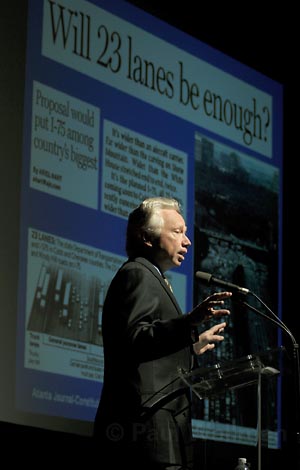Does Community Design Affect Health?
Better Living Through City Planning

The details that make it into the final version of Santa Barbara’s forthcoming General Plan update will affect whether city residents 50 years from now are basically out of shape or fit, fat, or slender, connected to one another or isolated, among other health factors. That was the sobering message environmental health expert Richard Jackson, MD, MPH, left with city planning commissioners, staff, and about 80 other citizens attending a forum on healthy communities on Saturday, January 19.
Jackson explained the fundamental relationship between urban planning and public health with a profusion of alarming statistics on obesity, diabetes, square miles lost to cement, polar ice lost to global warming, and much more. But there were moments of levity, such as when he cited the cost of additional jet fuel airlines must bear to compensate for Americans’ collective weight gain. (It’s $1.1 billion dollars per year, he said.)
The city’s General Plans-blueprints for growth put out every 20 years-have never included health goals or policies. But the forthcoming General Plan will have a health element, said City Councilmember Helene Schneider. Considering today’s range of epidemics, it’s easy to see why. Twenty-eight percent of fifth, sixth, and seventh graders and 36 percent of adolescents in Santa Barbara County are either obese or overweight and therefore at major risk of diabetes. Nine percent of county residents, or 38,790 people, already have diabetes. If current trends continue, girls raised in the United States will live an average of 14 years less than their parents. Student athletes in schools adjacent to freeways have three times the rate of asthma as athletes in other schools.
Jackson, who is the former head of the California Department of Health Services and the National Center for Environmental Health at the Centers for Disease Control (CCD), blames much of these trends on bad urban planning: community designs that prevent kids from walking and biking to school, that deprive people of convenient places to exercise and get around without a car, and that don’t bother with trees. “We’ve paved over an area equivalent to the state of Georgia,” Jackson said. “Sixty thousand square miles of impervious surface that gets hot in the summertime, produces no oxygen when the sun shines, and runs off whenever rain occurs, carrying pollutants into rivers and streams.”
The City of Santa Barbara and City College’s Continuing Education Department presented the forum, but it was more specifically the work of The Coalition for Community Wellness. This new group sprang from a conversation between City Councilmember Helene Schneider and longtime friend Kathleen Rodriguez of Sansum Diabetes Research Institute last winter. When Schneider mentioned the General Plan update process, Rodriguez brought up the connection between the way cities are built and the community’s health. They decided to get city planning staff and health professionals together to toss around ideas. A steering committee quickly formed, and in May it invited members of the healthcare community to a forum. Forty people showed up, including Cottage Health System CEO Ron Werft. At that forum, like Saturday’s, experts laid out the rationale for why urban planners should keep the public’s health in mind when formulating zoning, water, housing, and transportation policies. A handful of those listening, including Dana Goba of Cottage Health System and Jayne Brechwald of the American Lung Association, signed on to form the coalition.
Saturday’s event included a panel of directors from Santa Barbara agencies, including Anne Patterson, head of Nutrition Services at the county Public Health Department; Terry Dressler, director of the Air Pollution Control District; and Nancy Rapp, director of the City Parks and Recreation Department.
Patterson said nutrition and city planning were intertwined; research shows when people have access to healthy foods, rates of diabetes and obesity decline. Patterson then said 50 percent of all retail food outlets in Santa Barbara County were fast food restaurants, 25 percent were convenience stores, and 17 percent were supermarkets. Only 8 percent were farmers markets and produce stands.



